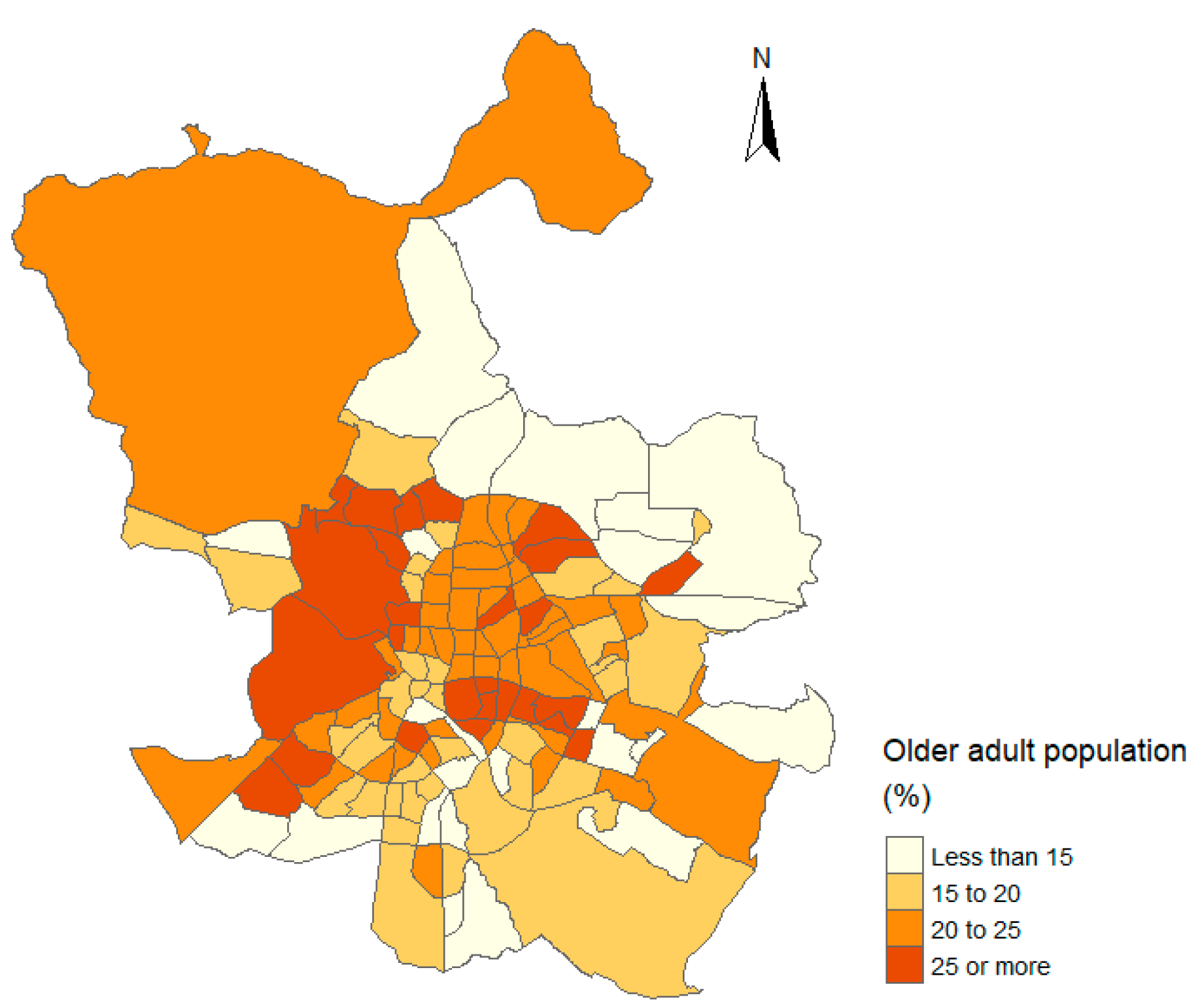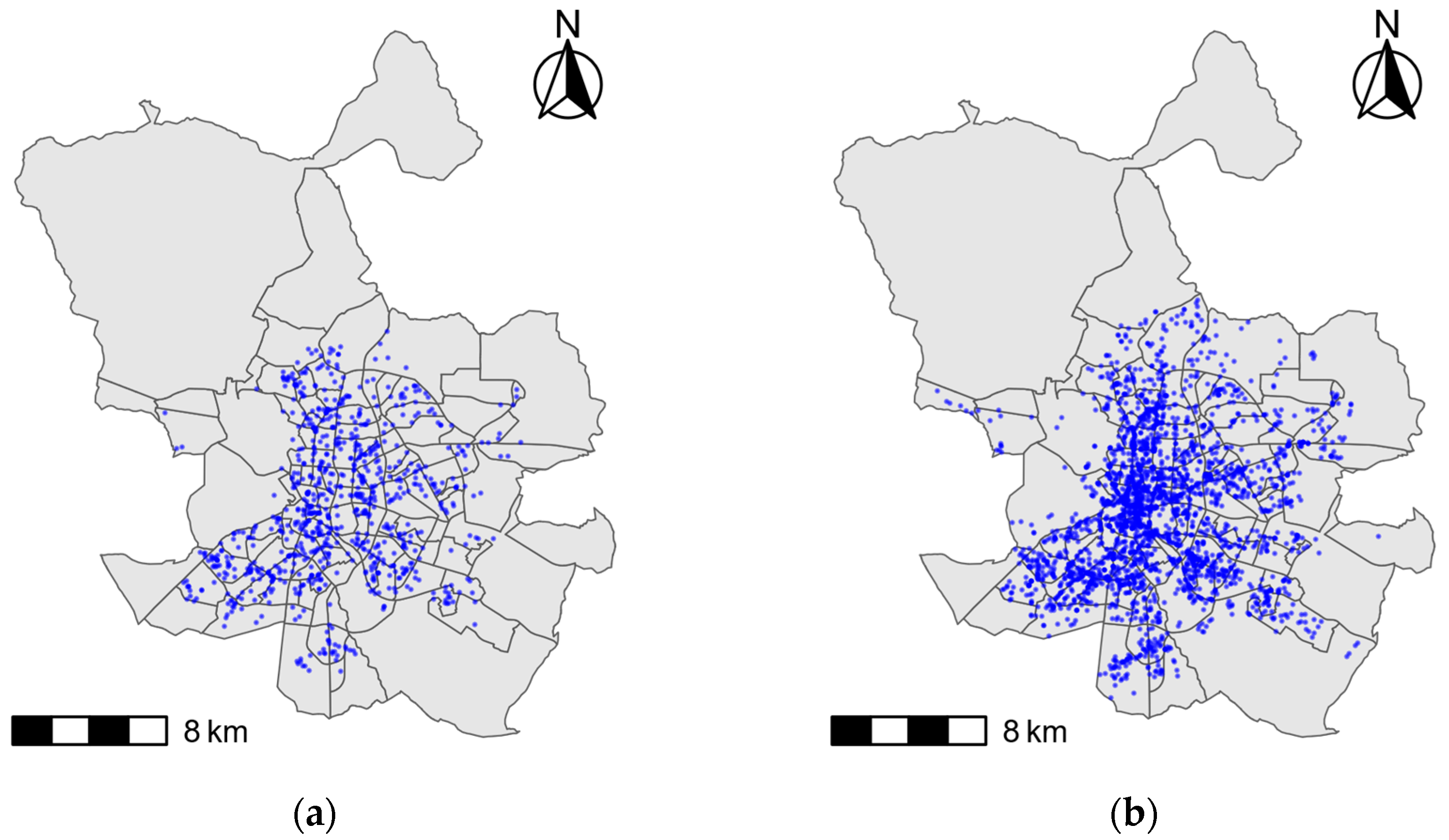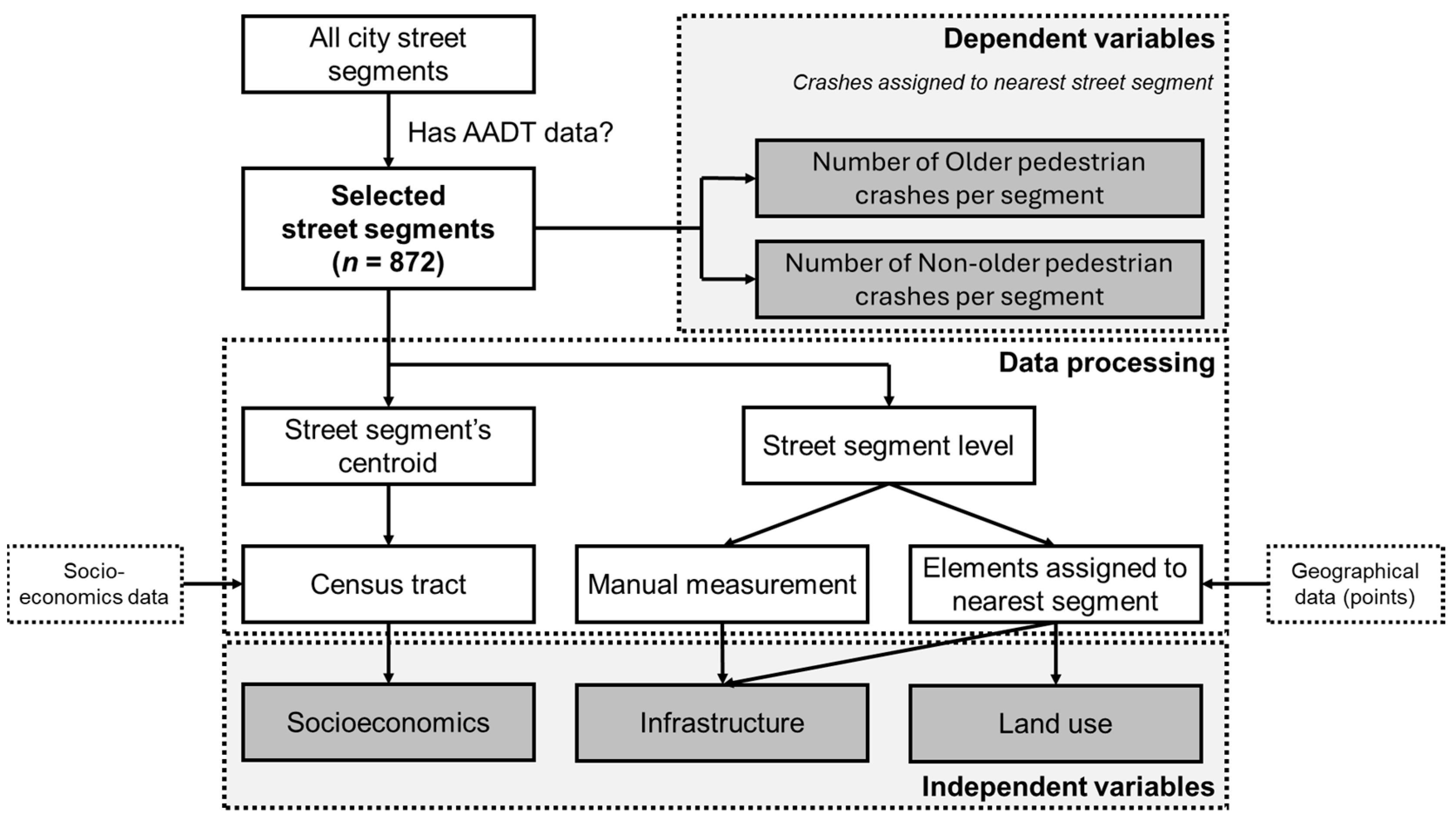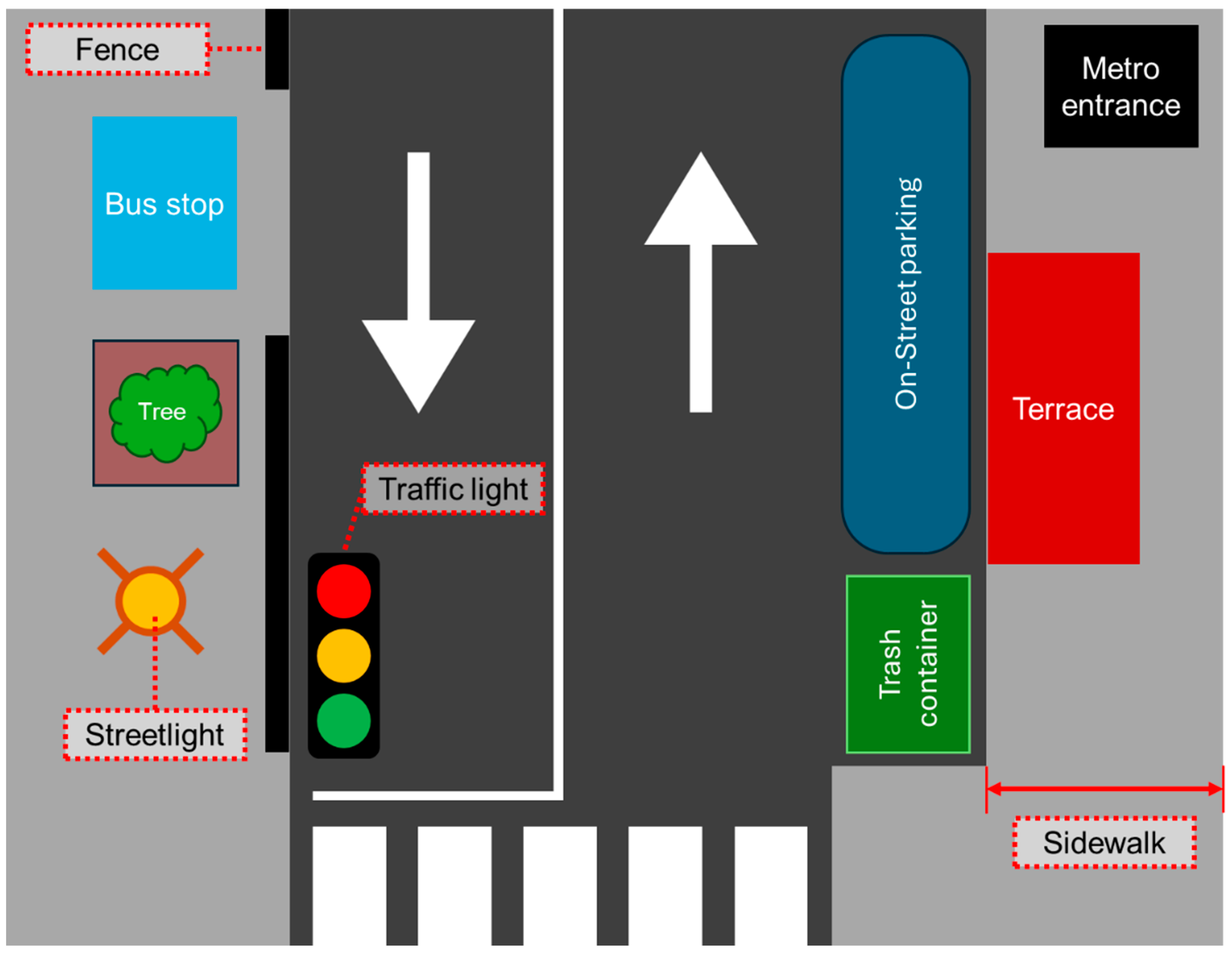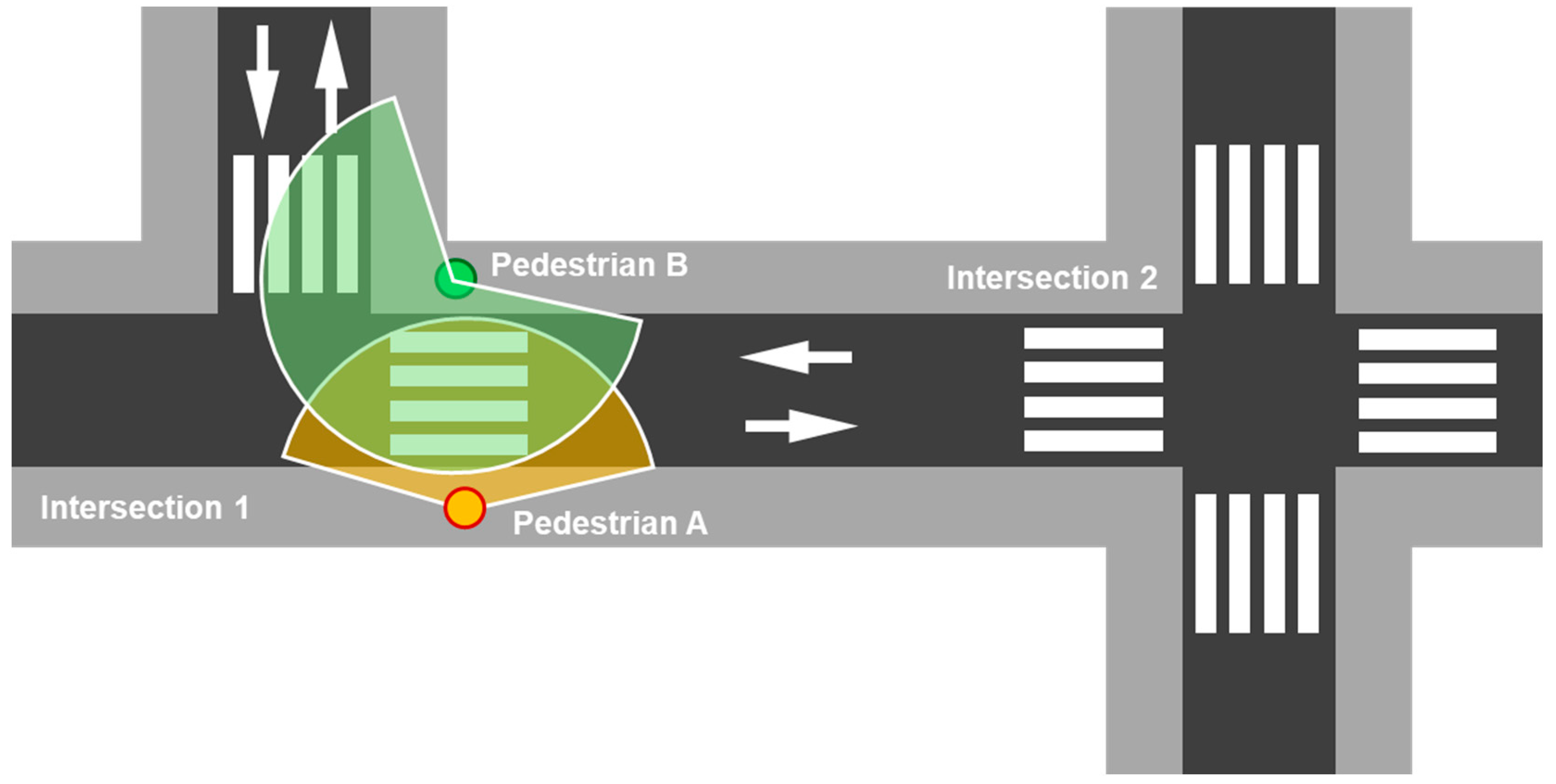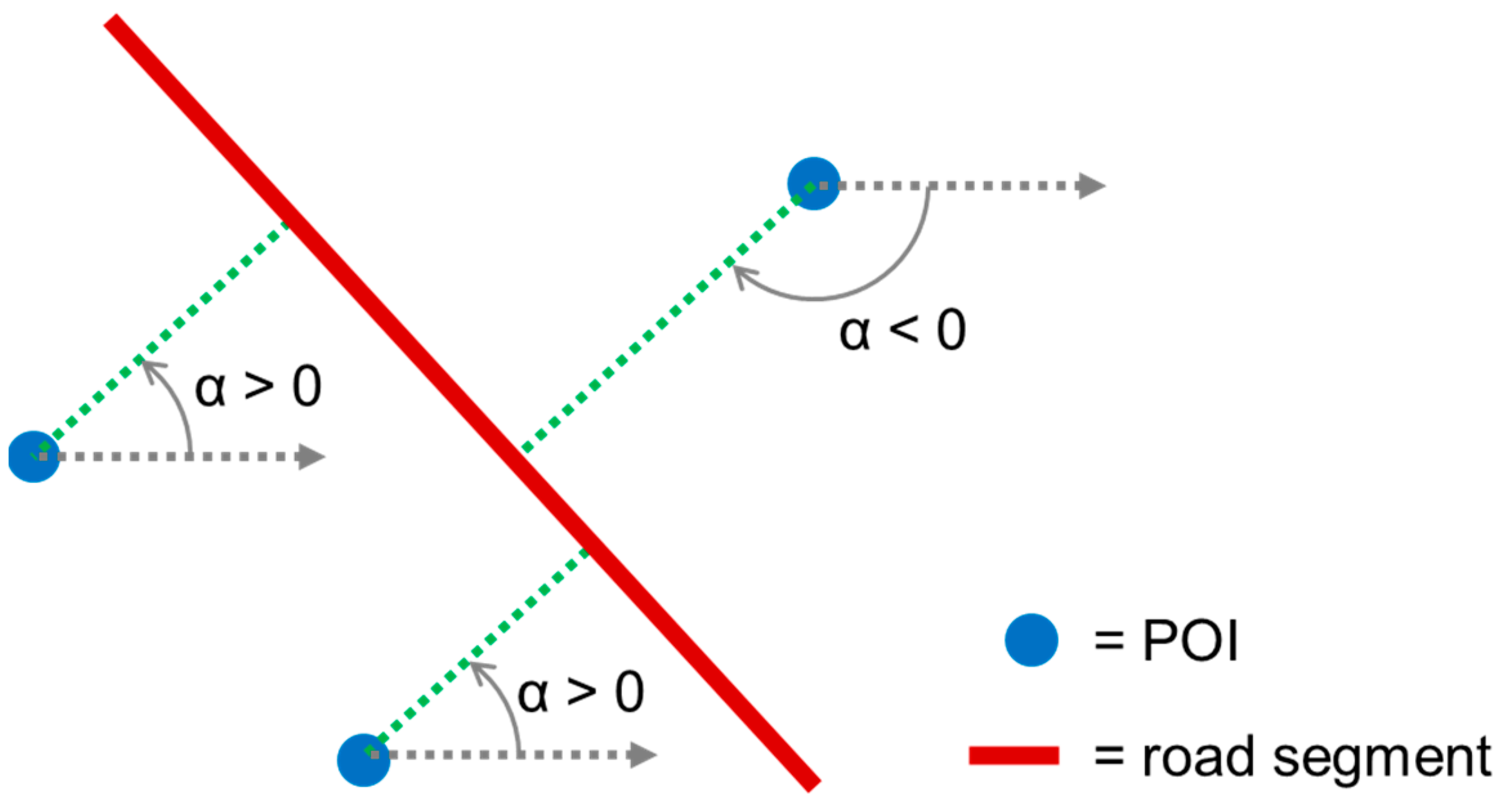1. Introduction
Walking offers substantial benefits for older adults (people aged above 65), serving as a cornerstone for maintaining physical health and promoting mental well-being. Regular walking helps to mitigate the risks of chronic diseases, cardiovascular diseases, diabetes, cognitive impairment and dementia, and even improve mental well-being, sleep, and longevity [
1]. Moreover, older adults benefit from walking in terms of social inclusion and a reduction in isolation [
2,
3], which is closely related with their well-being [
4,
5,
6]. In fact, older adults are particularly vulnerable to loneliness [
7] and marginalization because of their age, namely ageism. Ageism can be defined as negative or positive stereotypes, prejudice, and discrimination against older adults [
8]. This marginalization was exacerbated during the COVID-19 pandemic due to social isolation and physical limitations [
9,
10], and ageism was normalized because of the higher level of vulnerability of older adults [
11]. Despite the physical activity benefits of walking, this demographic is particularly vulnerable as pedestrians to vehicle collisions.
Older pedestrian (an older adult acting as a pedestrian) road safety is an issue of concern, as the aging population has already impacted crash data. In Europe, the proportion of older adults among those killed in traffic crashes nearly doubled from 17% in 1992 to 29% in 2018 [
12]. Specifically in 2020, older pedestrians accounted for 48% of pedestrian fatalities, despite comprising only 21% of the total population. This age group represents 28% of all road-related deaths [
13]. Therefore, despite the effects of COVID-19, which significantly reduced traffic volumes, older pedestrians continued to be highly vulnerable on the roads. This vulnerability is particularly pronounced in urban areas. To illustrate, in Spain, 64% of pedestrians killed on urban roads in 2021 were aged 65 or above, while this group represented only 20% of the population [
14]. Older pedestrians exhibit characteristics that increase their crash risk, such as chronic medication use, risk-taking behavior, distractions, and diminished self-regulation. In addition, their inherent physical frailty puts them at increased risk of injury [
15]. The aim of this study is to identify key factors contributing to traffic crashes within urban scenarios involving older pedestrians and to propose countermeasures to create more age-friendly cities.
The population of older people is expected to grow in the next decades [
16], so cities should be prepared to be safer and more inclusive to promote the benefits of walking and avoid social isolation because of poor safety perceptions related to traffic. Although there is an institutional willingness for the inclusion of the older population in public policies [
17], the body of research with real traffic crash data is not substantial. Traffic safety studies should be more inclusive to recognize and address the unique needs and risks associated with older pedestrians, as older people are often forgotten among other priorities [
18]. There is a need to detect which factors make streets riskier, particularly for older pedestrians, while countermeasures should promote safety but not reduce the operational performance of roads [
19], conflict with other goals [
20], or reduce the safety of other pedestrians. This is aligned with the definition of an age-friendly city, which is a place that adapts to be more inclusive to the needs of all ages [
21] and to promote healthy, active, and successful aging [
22], as it is based on minimizing the risk of disability (caused by traffic crashes) and maintaining physical functions (more safety implies more walking activity). This study is particularly in line with the health pillar of active aging [
23], especially preventing and reducing disabilities and premature mortality by creating safe environments. Regarding the United Nations’ Sustainable Development Goals [
24], this approach is aligned particularly with goals 10 (‘reduced inequalities’) and 11 (‘sustainable cities and communities’), and with the European ‘Vision Zero’ initiative [
25], which aims to reduce road traffic fatalities and serious injuries to as close to zero as possible by 2050.
Research on older pedestrian traffic crashes reveals several key factors influencing older pedestrian safety, and methodologically, this research can be divided into four groups: observational studies, surveys, simulations, and crash database analyses. Observational and pedestrian survey analyses [
26,
27,
28,
29] have highlighted that street crossings are particularly problematic areas, which is shown in the traffic crash data as older adults are over-represented in crashes at intersections, although about 70% of older adult fatalities occur on road segments [
30]. For example, Oxley et al. [
26] noted increased crossing difficulties in complex environments, like two-way undivided roadways, where older pedestrians struggled to process information from multiple sources, thus being at greater risk compared to younger individuals. This led to the recommendation of installing median strips in such areas to simplify the crossing process, which was supported by findings by other authors [
31,
32]. Bernhoft et al. [
33] showed that older pedestrians prefer routes with signalized intersections and smooth sidewalks, while younger pedestrians focus on the most direct route. Vine et al. [
27] found that dangerous pedestrian crossings, cyclist activity, overcrowded or busy road pathways, sidewalks in bad condition, a lack of shading, and public seating undermined older pedestrians’ sense of safety. Likewise, Ravi et al. [
34] identified older people’s preferences for better infrastructure, including better crosswalks with longer green lights, better-maintained sidewalks, and more lighting.
Simulation studies [
35,
36] underscored that education and training should be complemented with adjustments to infrastructure. Consequently, a focus on real crash data analysis is essential for reducing older pedestrian crashes. For example, early research by Zegeer et al. [
31] using data from North Carolina and the U.S. Fatal Pedestrian Crashes database over 11 years highlighted that older adults are more likely to be fatally injured in crashes, particularly at intersections and wide streets due to slower walking speeds and difficulties in complex traffic situations. A similar study by Martin et al. [
37] found that most crashes involving older pedestrians in Ireland occurred during daylight and in good weather conditions. Abou-Raya et al. [
32] noted that older pedestrians often did not notice approaching vehicles with falls being a common cause of injuries.
Another group of studies has aimed to identify unique characteristics of older pedestrian crashes using statistical and machine learning techniques. Kim and Ulfarsson [
38] utilized random-intercept logistic regression to discover that older pedestrians are more likely to be involved in crashes with older drivers, in scenarios involving vehicle turns, and they are less likely to be involved in crashes during darkness and summer. Das et al. [
39] identified that failure to yield while crossing and while a vehicle is turning at intersections were associated with older pedestrians. In particular, females were associated with backing vehicles and males were associated with segment-related crashes and crashes while crossing the expressway at night.
Using traffic crash databases, research into the injury severity of older pedestrian crashes has also been conducted. Wang et al. [
40] used an ordered probit model to analyze crash severity in Singapore, finding that more severe crashes tended to occur at night, on roads with high-speed limits, at three-legged intersections, and away from proper crossings, and they were lower at signalized intersections. Laković et al. [
41] also highlighted that older men and those over 65 were more likely to suffer severe injuries especially during the day and in traffic conditions that transition from infrequent to normal traffic. These studies, however, did not separate older pedestrian data for specific comparisons with other age groups, which limits the conclusions that can be drawn.
Apart from these previous studies, a detailed built environment analysis using real traffic crash data at the micro-level [
42] road segment level is largely missing. This gap in research prevents a comprehensive understanding of the infrastructure features that contribute to the frequency of crashes involving older pedestrians. A built environmental analysis of urban pedestrian crashes can be addressed at a territorial macro-level (e.g., at district or census tract level) or at a territorial micro-level (e.g., street intersection or street segment level), As explained below, micro-level studies are less common in the literature than macro-level ones or those only including exploratory analyses, and their scope is also quite different.
On the one hand, macro-level studies often analyze the number of crashes in larger spatial units like districts or neighborhoods. For example, Dumbaugh et al. [
43] found that the number of older adults, arterial roads and big box stores increased crashes involving older pedestrians, while dense networks of lower-speed roads reduced them. Social equity in pedestrian crashes was analyzed by Lee et al. [
44], studying the number of older and non-older pedestrians in Seoul (Korea) at the census block group level. This research showed that four-way intersections and crosswalks impacted the number of pedestrian crashes and the severity of older pedestrians only in low-priced-housing areas, implying that pedestrian measures may be unevenly distributed across the city. Research by Gálvez-Pérez et al. [
45], developed at the city district level in Madrid (Spain), found that built environment features such as vehicle flow, the presence of traffic lights, and sidewalk surface had a more statistically significant effect on older pedestrian collisions than on younger pedestrian crashes. A more recent study by Gálvez-Pérez et al. [
46], using all the Spanish municipalities as the case study, concluded that municipalities above 50,000 inhabitants were safer for older pedestrians, and that more populated provincial capitals had lower rates of older pedestrian traffic crashes. They also stated that countermeasures to improve the road safety of older pedestrians are not likely to worsen the safety of the rest of the pedestrians.
In relation to the scope of these territorial studies, the macro-level approach is suitable for medium- and long-term transportation planning, but short-term measures should be applied to street infrastructure, which is considered in these studies in an aggregated way. The specific location where the crashes take place is not considered with this spatial unit approach; thus, it is not possible to determine which specific road elements should be treated or redesigned.
Conversely, micro-level studies focus on specific road elements like segments or intersections. This approach allows for a more detailed examination of where crashes occur and the factors contributing to them. Unfortunately, due to data limitations, such detailed studies are scarce. Two exceptions are the paper by Kim [
47] and Lv et al. [
48]. Kim [
47] analyzed pedestrian traffic crashes at intersections in the County of Los Angeles (U.S.). Multinomial logistic regression was used to examine factors related to intersections with a high concentration of older and younger pedestrian collisions. The research found that certain features like raised medians and proximity to recreational areas improved safety for older pedestrians, whereas bus stops increased collision risks. However, the results of this study cannot be extended to road segments, where a large number of crashes take place. Lv et al. [
48] studied the number of older pedestrian traffic crashes occurring at each road segment in a Shanghai district using Poisson and Geographically Weighted Poisson regressions, revealing that the safety of older pedestrians was significantly influenced by the presence of green spaces, sidewalks, and road junctions. Additionally, this study identified roads near nursing homes, schools, bus stops, metro stations, traditional markets, and supermarkets as particularly dangerous for older pedestrians. However, the research did not compare results with traffic crashes involving the rest of the pedestrians (aged below 65). This omission is crucial for policymakers, as some road features might be riskier for all pedestrians, while others could affect older adults only. If only crashes involving older adults are studied, special measures for this demographic that should be applied to the entire population might be proposed. Furthermore, road segments are defined as 200 m segments and might include road junctions. Hence, this study includes crashes on road segments and road junctions but analyzes only the characteristics of the road segments. Finally, although they use a novel data collection technique through street-view imagery, some physical features (variables) that might interact with pedestrians were not included in the study.
In this literature context, there is an absence of studies on older pedestrian road safety at the street segment level covering a holistic set of infrastructure variables to reflect most of the elements present in the streets, such as the presence of trees, trash containers, fences or terraces, and the intersections at the edges of the segment. There is also a lack of literature comparing older and non-older pedestrian traffic crashes at the segment level to identify factors related to the occurrence of all pedestrian crashes and those that affect specifically older pedestrians. The objective of this study is to identify critical factors influencing traffic crashes involving older pedestrians and propose countermeasures to create more age-friendly cities, especially focusing on infrastructure features. This approach holds significant value for policymakers and urban planners, as it will enable the identification of short-term infrastructure measures to mitigate older pedestrian traffic crashes. At this stage, traffic crashes on road segments were studied, as in Spanish urban roads, nearly two thirds of pedestrians were killed or injured on road segments [
49], outside of intersections. The methodology relies on a Poisson model in a Bayesian framework utilizing the Integrated Nested Laplace Approximation (INLA) approach, which is employed to predict separately older and non-older pedestrian traffic crashes per road segment. The analysis utilizes a dataset spanning a 5-year period of pedestrian crashes in Madrid, Spain, in which 872 road segments have been studied.
The structure of this paper is as follows:
Section 1 comprises the introduction,
Section 2 describes the materials and methods, including the case study, database elaboration and description, and the statistical modelling approach;
Section 3 includes the modeling results;
Section 4 contains the discussion, and finally,
Section 5 provides the conclusions, including future research lines.
3. Results
This section outlines the results derived from statistical modeling. Unlike deterministic methods, Bayesian statistics express uncertainty directly through inferred posterior distributions of the parameters. The mean of each parameter is presented along with its 95% and 90% Bayesian credible intervals (BCIs), which are represented by the 2.5% and 97.5% quantiles, and 5% and 95% quantiles of the posterior distribution, respectively. The effect of a variable is considered credible at a specific level when the corresponding BCI does not include zero. Unlike confidence intervals in frequentist statistics, which provide a range that would contain the true effect in a certain percentage of repeated samples, BCIs directly reflect the degree of certainty about the parameter’s value given the observed data. These results are illustrated in
Table 5 (older adult pedestrian crashes model) and
Table 6 (non-older adult pedestrian crashes model).
Both models reveal that certain variables influence all pedestrians with credible effects. These include Average Annual Daily Traffic (AADT), the density of leisure POIs, the presence of bus stops, and the density of crosswalks, all of which increase the expected number of crashes for all pedestrians. The precision value of the heterogeneity effect indicates that the covariates explain most of the data dispersion.
Apart from these effects, the number of traffic crashes involving older pedestrians is also affected by population density, the presence of trees on the sidewalk, the presence of trash containers, and the level of contour complexity. Higher population density increases collision risks. Trees and trash containers are also related to riskier streets. Roads ending in three-legged intersections (complexity A) are riskier compared to those without three-legged intersections (complexity C), while no credible effect is noted for complexity B. These variables have consistent but non-credible effects in the non-older pedestrian model.
Apart from the common patterns between both models stated above, the safety of non-older pedestrians is influenced by terraces, metro stations, and street type. Streets with terraces or metro entrances are riskier. Compared to one-way streets, two-way streets with a median are safer, while two-way streets without a median show no credible difference in safety. Interestingly, the effects of terraces and two-way streets with medians are opposite for older pedestrians, but these effects are not credible.
The remaining covariates did not show credible impacts in either model. Streets with no streetlights, less slope, fewer lanes, no traffic lights, and no on-street parking are riskier for all pedestrians. Additionally, two-way streets without medians and streets with intermediate contour complexity (complexity B) tend to have fewer pedestrian collisions. On the contrary, some variables demonstrated opposite effects between the two models. For instance, streets with more health and education POIs, fewer public POIs, and a more balanced distribution of leisure POIs are riskier for older pedestrians. Features contributing to safer conditions for older pedestrians included wider and better-balanced sidewalks and pedestrian fences. These effects are opposite in the non-older pedestrian crashes model.
4. Discussion
This section discusses the practical policies derived from the modeling results. The exposure variables, length and AADT, were associated with all pedestrian traffic crashes. Segment length was used as an offset variable, fixed at 1, which is in line with other authors [
57,
75]. AADT consistently increased pedestrian crashes, affirming its significance across all pedestrian groups.
Regarding the socioeconomic factors, population density showed a positive credible impact on older pedestrian crashes, which is consistent with previous literature [
45], although it was not credible in the non-older pedestrians’ model. Higher average income per capita reduced all pedestrian collisions, which was expected due to better infrastructure maintenance and safer pedestrian behaviors [
76]. The same result was found by other authors [
45], but the effect of this variable was not credible.
Among land use factors, the presence of leisure points of interest (POIs) was the only credible variable, increasing crashes for both older and non-older pedestrians. Leisure POIs attract pedestrians who might walk around them without paying special attention to traffic and may feel safer due to crowded and well-maintained areas, leading to increased crashes. Similar results were reported by Lee et al. [
44] for older pedestrians and by Zhu et al. [
65] for pedestrians in general.
The most notable differences between the age groups were found in the infrastructure variables, which can be modified in the short-term to reduce crashes. Trees on sidewalks increased crashes for older pedestrians due to narrowed sidewalks and navigation hazards, making them more likely to walk on the pavement. This factor did not affect non-older pedestrians.
The most notable and interesting differences between the two age groups were found in the infrastructure variables, which are the most feasible factors to modify in order to reduce pedestrian crashes for older individuals or the general population.
Regarding the ease of walking on the sidewalk, the presence of trees was linked to increased crashes involving older pedestrians due to two main reasons. First, trees narrow the effective width of sidewalks with uncovered tree pits posing navigation hazards. This issue is exacerbated on narrow sidewalks, leading older adults to walk on the pavement, increasing their crash risk. Second, older individuals might prefer walking in areas with vegetation, resulting in higher pedestrian traffic and more crashes. This factor did not affect younger pedestrians, who navigate these sidewalks more easily.
The occurrence of non-older pedestrian crashes is influenced by two factors. First, restaurant terraces on sidewalks might impede pedestrian transit and reduce the ability to detect oncoming vehicles, increasing crashes. Non-older pedestrians may cross streets with terraces in undesignated areas, unlike older pedestrians who show a greater willingness than non-older people to cross at designated areas only [
33]. Interestingly, the effect on older pedestrians is opposite, although not credible, which could indicate that terraces have a benefit for them serving as a barrier to vehicles. Second, metro station entrances on sidewalks are linked to more non-older pedestrian crashes, which is likely due to their attraction. Older pedestrians do not show this effect, which is possibly due to reduced metro usage by people over 64, who prefer the use of bus [
77]. Similar results were found by Gálvez-Pérez et al. [
45]. Streets with bus stops are riskier for all pedestrians, which was something already noted by Lv et al. [
48] for the older pedestrian case. Buses might disrupt traffic flow and obstruct the view of oncoming vehicles with visibility further reduced at some bus stops due to opaque billboards.
In examining variables linked to the ease of crossing the street, crosswalk density is the only credible predictor, correlating with increased pedestrian crashes due to higher interactions between pedestrians and vehicles. Li et al. [
78] found that older people feel safer in areas with more intersections, typically characterized by increased crosswalks, although these crosswalks would be located at intersections, which is outside the scope of our study. There is a need to protect these areas, especially for older pedestrians. Other non-credible variables show interesting effects. Traffic lights mitigate crashes by controlling traffic and reducing speeds. Pedestrian fences should lower crashes by acting as barriers, restricting crossings to designated areas. Older pedestrians, in particular, perceive a road safety benefit in streets with fences. However, younger pedestrians experience the opposite effect. This finding is similar to streets with terraces, where older individuals may tend to use designated crossing points, whereas younger ones might choose alternate paths, including potentially jumping fences, which is easier for them.
Regarding the ease of detecting traffic, credible variables are only found in the older pedestrian model. Trash containers, often placed on sidewalks or pavements, obstruct vision and make it more difficult for older individuals to detect traffic, especially those with visual or hearing impairment [
15]. Streets with these containers were found to be riskier for older pedestrians. Streets with contour complexity level C (other than three-legged intersections at both ends) are associated with fewer crashes involving older pedestrians compared to streets with level A complexity (three-legged intersections).
Road safety education for older adults, which is already planned in Madrid [
79], should be complemented with other measures. Regarding practical applications of this research for policymakers, modeling results suggest short-term road infrastructural measures that could be implemented to decrease the incidence of traffic crashes involving older pedestrians. Trees, while enhancing urban livability and providing benefits, including economic, social, and health benefits [
80,
81], may pose obstacles for older individuals on narrow or crowded sidewalks by significantly reducing available space. Furthermore, older adults may perceive fall risk if the tree pits are not properly maintained. It is advisable to avoid placing trees on streets with narrow sidewalks. More ideally, relocating trees to areas outside the sidewalks would potentially reduce on-street parking spaces, which would extend additional space for pedestrian use. It is important to select tree species that are appropriate for the given urban environment, particularly those that are suitable for narrower spaces. In wider sidewalks, covering tree pits with tree grates, usually metallic, can enhance safety by preventing potential trip hazards. In addition to improving the traffic safety, these measures would reduce the potential risk of falls, which is something especially beneficial for older people due to their longer recovery processes.
Trash containers, typically located near parking lots, present a more significant visual barrier for older pedestrians than parked vehicles due to their size and shape. Their placement can impair traffic detection, especially when positioned between pedestrians and approaching traffic. To improve traffic detection for older pedestrians, trash containers should be placed away from crosswalks and road junctions, avoiding any reduction in sight distance. Placing the containers between the pedestrians and the oncoming traffic should be avoided. It is recommended to position them close to the sidewalk edge despite the logistical challenges of moving them for emptying. Even minor increases in the gap between the sidewalk and a container can significantly improve sight distance. Marking optimal container placements on the pavement could ensure proper positioning.
Bus stops and crosswalks were found to increase all pedestrian crashes. Like trash containers, bus stops near crosswalks can block vehicle sightlines. To mitigate this, bus stops should avoid obstructing vision and could be replaced with posts. High-traffic bus stops crowd sidewalks and block sightlines, raising pedestrian crash risks and potentially leading to more severe injuries if a pedestrian is hit by a bus [
82]. Safety could be improved by marking these areas and installing pedestrian fences where feasible. Regarding crosswalks, the main objective should be to properly mark and condition existing crosswalks, especially on wide streets, and extending green traffic light phases, as older pedestrians walk at slower speeds [
28,
29,
83]. In older neighborhoods, this could enhance safety. Although the effect of traffic lights was not statistically significant, their installation could be beneficial by slowing down vehicle speeds, which is associated with less severe injuries in collisions [
84,
85].
It should be noted that all credible variables in both models show a consistent effect on the safety of both older and non-older pedestrians. Additionally, there are variables showing opposite effects on those age groups, but these are only credible in one or neither of the models. Consequently, none of the proposed countermeasures aimed at enhancing the safety of older pedestrians should result in a deterioration of safety for other pedestrians.
5. Conclusions
This study employed a Poisson model within a Bayesian framework, utilizing the Integrated Nested Laplace Approximation (INLA) approach, to analyze factors influencing traffic crashes involving both older and non-older pedestrians. A holistic view of the road segments was used through a wide set of infrastructure variables, including less common ones like restaurant terraces, trash containers, and on-street parking. These variables were analyzed to propose short-term countermeasures. Based on the results, we propose measures such as a better placement of trees, trash containers, and bus stops, installing more crosswalks and traffic lights, and extending the green phase of existing traffic lights. These improvements aim to enhance the safety of older pedestrians without compromising the safety of other pedestrians. Furthermore, they should be implemented without compromising the road’s operational performance or contributing to traffic jams.
The limitations of this study are mainly related to data availability. Average Annual Daily Traffic (AADT) data, crucial for analysis, was not available for all street segments, only for certain segments. Fortunately, these street segments are spread across various street types and areas, making them representative of the city network. Another limitation is the absence of pedestrian flow data, which is only collected on major streets in Madrid. For a more detailed analysis, pedestrian flow data categorized by age groups, specifically older versus non-older pedestrians, would be beneficial to better understand the dynamics and risks associated with each group.
Future research should address these issues to enhance the understanding of older pedestrian traffic safety. Ad hoc measurements of street and sidewalk widths limit data collection to a few records. While micro-studies are effective in developing infrastructure countermeasures, using small areal units in macro-studies (such as regular grids) could simplify data collection, reduce manual efforts, and minimize measurement errors. Additionally, calculating the ‘effective width’ of sidewalks and its impact on traffic crashes involving older pedestrians is a promising research direction. This would require precise measurements of actual sidewalk widths and the identification of elements that constrict these widths.
Despite a general willingness to develop inclusive urban spaces, prioritizing the integration of older pedestrians is crucial. This demographic faces a higher risk of fatalities and serious injuries from vehicle collisions and is vulnerable to social exclusion and isolation, which can result from reduced walking activity. Given the expected aging population in developed countries, additional efforts are needed to ensure their safety and inclusion in age-friendly urban planning initiatives. Such inclusion should not only create safer streets for older adults and promote walking activity among this group but also help to reduce ageist stereotypes.
The scientific community, particularly road safety experts, must be sensitive to the needs of the older population and their social integration challenges. This approach is essential for generating practical, applied research with effective policy proposals for road infrastructure interventions, aiding in the design of age-friendly cities.
